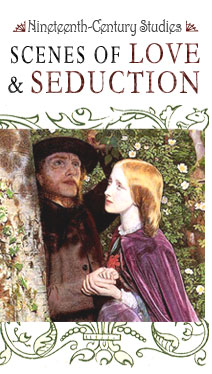Richard A. Kaye , The Flirt's Tragedy: Desire Without End in Victorian and Edwardian Fictionfrom Chapter One (2002)
Transcribed from pages 2-3 and 4 of Richard A. Kaye's The Flirt's Tragedy: Desire Without End in Victorian and Edwardian Fiction. Published by University of Virginia Press, 2002.
1.
"Desire, particularly as opposed to romantic love, has been the subject of intense, widespread critical scrutiny in the last twenty years in the works of postmodern Continental theorists and those writing in an Anglo-American context. Roland Barthes's strict distinction between desire as opposed to romantic love has been extremely influential. Thus Robert Polhemus, implicitly expanding on Barthes's distinction, has used the term 'erotic faith' to describe romantic love, noting that throughout European culture narratives of love have served to imagine 'forms of faith that would augment or substitute for orthodox religious visions.' Critics addressing the strictly formal dimensions of literary texts, as well as theorists seeking a more politically pronounced emphasis on how fiction operates in a matrix of cultural determinants, have turned to desire as a crucial locus of meaning. Rene Girard's exploration of 'triangular desire'; Barthes's intensely personal endorsement of 'bliss' and 'pleasure'; the hymeneal 'dissemination' evoked by Jacques Derrida; Julia Kristeva's semiotic, signifying stress on process; Leo Bersani's focus on the fluid fragmented staging of desublimated carnality; Judith Butler's elaboration of sexuality as sheer 'performance'; Tim Dean's Lacanian exploration of desire as fundamentally impersonal—have all accentuated an eroticism that is mutable and unstable, in which functional desire emerges as a historical aberration. For many postmodern critics, that aberration is a scandalously successful nineteenth-century literary invention that has come to legitimize patriarchally and heterosexually structured social scenarios" (2-3)
2.
"....In a male-dominated order, in which marriage was prized as a satisfying resolution, flirting represents a reckless adventurism that violates—and sometimes succeeds in undermining—the smooth functioning of middle-class interests and aspirations. Within the context of nineteenth-century fiction, that violation often emerges as a subtly intimated, dissident gesture at the center of a larger, apparently well-settled narrative of connubial bliss" (4).








